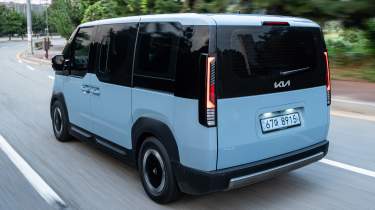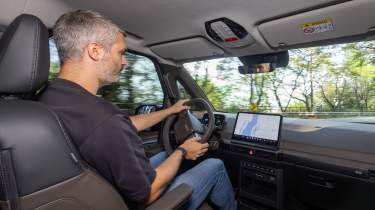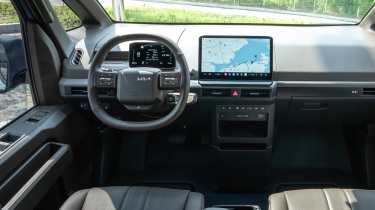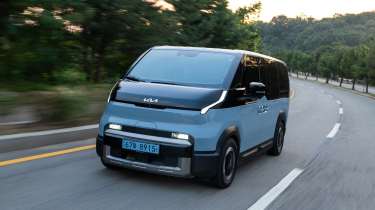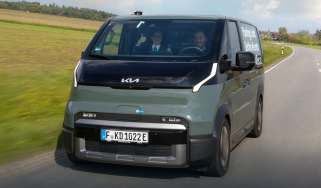Kia PV5 review
The Kia PV5 is a new-age take on the big, seven-seat family car. Now might be the time to ditch the SUV for something properly practical

Our opinion on the Kia PV5
You might struggle to believe that a glorified van with windows could warrant such a high star rating, but the Kia PV5 moves the needle when it comes to big, affordable electric cars. Granted, the model tested can’t yet carry a full rugby sevens team, but assuming it doesn’t command a big premium, that version could be the best-value new car of 2026.
| Key specs | |
| Fuel type | Electric |
| Body style | Five or seven-seat MPV |
| Powertrain | 51.5kWh or 71.2kWh battery, 120bhp or 161bhp e-motor |
| Safety | NA |
| Warranty | Seven years/100,000 miles |
About the Kia PV5
Has the unrelenting popularity of SUVs finally plateaued? Are buyers becoming wise enough to the inherent space and efficiency compromises to divert their hard-earned cash into something boxier and more family friendly?
Kia is hoping so, and its answer is this: the all-new PV5 Passenger. It’s based on the PV5 Cargo, and is an alternative to the retro-styled Volkswagen ID. Buzz, as well as seven-seat SUVs such as the Peugeot E-5008 and Hyundai Ioniq 9. Pre-orders are open now, and deliveries are due before the end of 2025.
Measuring 4,695mm long, the PV5 is 17mm shorter than the base Buzz, and while a choice of five and seven-seat layouts will be available, there’s no extra-long version as offered on the VW. In addition to being a little more compact, the Kia is also down on power, range and charging speed compared with its European counterpart.
Used - available now

2022 Mercedes
CLA Shooting Brake
31,342 milesAutomaticPetrol1.3L
Cash £21,495
2020 Volkswagen
Arteon
66,000 milesAutomaticDiesel2.0L
Cash £16,600
2025 Vauxhall
Astra
26,656 milesAutomaticPetrol1.2L
Cash £15,900
2021 Mercedes
A-Class
37,877 milesAutomaticDiesel1.5L
Cash £16,100But more on those points in a moment, because the fact is this new Kia is also a lot cheaper to buy. While we don’t yet have full UK specifications, Kia has confirmed that the Cargo version will start from £27,645 (plus VAT) before the plug-in van grant, while the seated version we’re driving here costs £32,995 if you can make do with the smaller battery and cheaper trim. At the time of writing, you can’t buy a Buzz for less than £59,135.
The PV5 uses Kia’s E-GMP.S platform, which has a couple of intricacies that may be of benefit in the real world. The first is its Cell-to-Pack (CTP) tech which, with increased battery density, should offer tangible efficiency gains. The second is its front-driven layout; with all the hardware mounted low and ahead of the driver, this MPV can do what MPVs do best – concentrate on functionality above all else.
Kia PV5 prices and latest deals
The Kia PV5 is priced from £32,995 in five-seat passenger guise, rising to £38,295 for the bigger-battery model in the top trim. A seven-seater will join the range in 2026. There’s also a panel van available starting at £27,645 (ex.VAT). However, being so new, there aren’t currently any deals or offers listed on our Buy a Car service; expect these to start trickling through towards the end of this year.
If you're in the market for a big electric car now, though, you can get our hands on a new Kia EV9 for less than £60,000.
Performance & driving experience
| Pros |
|
| Cons |
|
Given how strong the PV5 package is, the way it drives is virtually inconsequential. As long as it can get you from A to B with little fuss, it’s a winner, right? Sure, but the capable Kia is so much more than that; we found it to be stable, nippy, comfortable and quiet, as well as safe and manoeuvrable around town. It feels remarkably car-like for something that shares its platform and body with a panel van.
You could reasonably expect the 161bhp e-motor to struggle on the open road, yet while we were never driving with more than two occupants, even the PV5’s Eco setting had enough grunt to keep pace with other traffic. This seemed to have a positive effect on the range read-out, too, so we left it in the most efficient mode for the majority of our drive.
We found the steering to be light, but the suspension did a great job of soaking up lumps and bumps, even on the countless sections of rough or rutted highway to the west of Seoul. We thought refinement was excellent for something so bluff-fronted, too.
The brakes are also worthy of mention. While the pedal feels smooth and progressive, we relied heavily on Kia’s intuitive multi-stage regenerative braking set-up on our drive. The system is easily adjusted via paddles on the steering wheel and can switch from friction-free coasting to forceful one-pedal driving at the flick of a switch. Treat it like old-school engine braking and you’ll find you barely even brush the brakes in day-to-day driving.
Electric motors, 0-60mph acceleration and top speed
The base Standard Range PV5 gets a lower-power 120bhp motor, though we’ve not yet had an opportunity to try this version. However, with 161bhp sent through the front axle, we expect the Long Range will be better equipped to haul the van’s bulk – especially with a full load. Officially, the more powerful motor cuts the 0-62mph time from 12 seconds to 10.7 seconds, while top speed on both is pegged at just 84mph.
We’ve so far only driven the PV5 with two people on board. It felt punchy enough for day-to-day driving, never struggling to keep up with faster moving traffic. That might change with a full rugby sevens team on board, so make sure you try before you buy.
| Model | Power | 0-62mph | Top speed |
| Kia PV5 Standard Range | 120bhp | 12.0s | 84mph |
| Kia PV5 Long Range | 161bhp | 10.7s | 84mph |
Town driving, visibility and parking
The big glasshouse and short front end mean the Kia PV5 is surprisingly easy to drive around town. Clever visual trickery lowers the window line for the driver and front passenger, which helps more than you might imagine when manoeuvring – further aided by the tall, upright driving position. Every version gets a reversing camera, too.
Country road driving and handling
The PV5 is no sports car, but nor does it claim to be. It handles really neatly for a tall, boxy MPV with a comfortable ride and just enough poke to ensure you’re not left languishing alongside faster-moving traffic. The steering is light but accurate, meaning you’re always confident you know where the front wheels are pointing.
Motorway driving and long-distance comfort
We found the PV5 to be surprisingly adept on the motorway given its bluff shape. There’s very little wind or road noise, and the car-like ride and handling mean it’s no chore to drive long distances. It proved pleasingly efficient during our early drive in South Korea, with the temperature hovering at around 22 to 23 degrees Celsius.
“The Kia PV5 is remarkably car-like to drive. Sure, it’s big and boxy, but you sit high and the view out is excellent. Comfort and refinement are also very good for a vehicle such as this.” - Richard Ingram, deputy editor
Range, charging & running costs
| Pros |
|
| Cons |
|
While the Cargo van comes with three battery options, this Passenger variant is available only with the larger 51.5kWh and 71.2kWh set-ups. Kia UK hasn’t detailed specs for the smaller battery, but industry data expert CAP quotes a maximum range of just 183 miles for the cheaper model. Despite the attractive starting price, for an extra £3k we think it seems sensible to step up to this Long Range version, which, on paper, extends the van’s usability considerably – topping out at 256 miles on the WLTP test cycle.
Electric range, battery life and charge time
We found that estimate to be rather conservative, too. During our testing, we covered more than 120 miles over a mixture of roads – including plenty of motorway and stop-start urban work – and we averaged a thoroughly respectable 4.1 miles per kWh in mild conditions. Even if you factor in the PV5’s reduced usable battery capacity of around 67kWh, that’s nearly 275 miles on a full charge.
Despite shunning the EV6’s 800-volt electrical architecture in favour of a more affordable 400V set-up, the PV5 boasts charging speeds of up to 150kW. That’s down on the Buzz’s 200kW peak, but competitive enough among rivals. It means a 10 to 80 per cent top-up should be achievable in around 30 minutes, via the handily placed charge port on the nose of the vehicle.
Insurance groups
Car insurance groups for the Kia PV5 haven’t been announced, but we expect it to sit in a lower banding than the ID. Buzz, which starts around Group 37.
Tax
The most expensive PV5 is priced at £38,295, meaning it avoids the luxury supplement applicable to cars costing more than £40k. Owners pay £195 per year in VED.
Depreciation
While depreciation, in percentage terms, is worse than the equivalent ID. Buzz, the fact it cost so much less at the point of purchase means you could save in the long run. Our data specialists suggest the PV5 will retain between 50 and 51 per cent of its value after three years and 36,000 miles, with the strongest RVs apparently for the mid-range PV5 Essential fitted with the bigger of the two batteries. The Buzz betters the Kia’s numbers by around 10 per cent (59-61 per cent depending on specification).
| Model | Battery size | Range | Insurance group |
| Kia PV5 Standard Range | 51.5kWh | 183 miles | NA |
| Kia PV5 Long Range | 71.2kWh | 256 miles | NA |
Interior, design & technology
| Pros |
|
| Cons |
|
There are two trims to choose from: Essential and Plus, although the latter is available only with the larger of the two batteries. Kia hasn’t detailed exactly what kit each version will get, but CAP suggests all models have a twin-screen infotainment system with a built-in reversing camera, wireless Apple CarPlay and Android Auto, as well as a six-speaker stereo, automatic climate control and LED lights, plus relatively modest 16-inch alloy wheels.
Upgrade to Plus and, again according to CAP, you’ll add things such as a power tailgate, heated seats and steering wheel, wireless phone charging plus additional safety features including bind-spot assist and smart cruise control. You’ll also throw in vehicle to load (V2L) capability – all for just £2,300 more than Essential spec with the bigger battery. All things considered, we’d make the rare recommendation to opt for the range-topping trim.
Interior and dashboard design
The PV5’s interior is best described as functional, but that doesn’t mean it’s totally devoid of design flair. The dash comprises a large 12.9-inch touchscreen and a 7.5-inch driver’s display – the latter nestled behind a quirky two-spoke steering wheel with familiar buttons and a drive-mode control in the centre.
The front seats give a commanding view of the road, but only feature a fold-down armrest on one side, so it can feel as if you’re sitting a little lop-sided at times. You can rest your other arm on the top of the door, but it’s not always the most comfortable.
There are sufficient cubbies and storage spots – including two set into the floor by the driver and front-passenger’s feet. We’re not sure what you’ll end up using these bins for, however, because they’re not the most accessible or easy to open.
Materials and build quality
The PV5 doesn’t feel built to a price as such, but it won’t be winning any awards for its luxury materials or high-end features. That said, while there are scratchy plastics on the dashboard or door tops, it’s no worse than most other van-based people carriers – especially those from Peugeot or Citroen. Indeed, the steering wheel and seats – the areas you’re in constant contact with – are covered in plush materials that feel soft to the touch. Ultimately, the Kia PV5 is a car designed to withstand the abuse of family life, and we’re pretty confident it’ll fulfil that brief and then some.
Infotainment, sat-nav and stereo
Somewhat perversely, the infotainment system in the PV5 feels like an upgrade compared with most of the brand’s passenger cars – even the flagship EV9. You don’t get that single panel that runs from behind the steering wheel to the centre of the dash, but the two displays feature crisp graphics with easy-to-read fonts and a reasonably intuitive menu structure. Wireless Apple CarPlay and Android Auto is also included, though you’ll need to step up to the Plus trim for wireless phone charging.
The PV5’s main USP is that it’s set up to support third-party apps, which will be of particular interest to those looking to run a PV5 Cargo for their business. Such systems could allow customers to control the refrigerated rear compartment, for example, or use a route-planner for parcel drop-offs.
“Material quality inside the PV5 is reasonable, if far from exceptional. But it should stand up well to the rigours of family life.” - Richard Ingram, deputy editor
Boot space & practicality
| Pros |
|
| Cons |
|
The PV5 Passenger is unashamedly based on the Cargo version of the van with the same name, so it’s no surprise that it gets full marks for practicality. It’s massive inside, whether you’re looking to carry people, luggage or both. The rear-seat compartment is frankly huge, and the boot should swallow anything your family can throw at it.
One small annoyance is that the front windows can’t (or won’t) lower completely, while those in the back are restricted to a small sliding porthole if passengers feel the need for some ventilation. Our car was an early five-seat model, so at this stage we’re unable to offer any verdict on the third row, although we suspect – given the size of the boot – that big kids will be just fine back there. Certainly more so than those forced into the rear of a Peugeot E-5008.
| Dimensions | |
| Length | 4,695mm |
| Width | 1,895mm |
| Height | 1,923mm |
| Number of seats | Five (seven-seat model on sale in 2026) |
| Boot space | 1,320/2,300 litres |
Dimensions and size
At just under 4.7 metres long, the PV5 isn’t as cumbersome as you might expect. It’s more than 300mm shorter than a BMW 5 Series and 17mm stubbier than a Volkswagen ID. Buzz, which should make it easy enough to live with day to day. Indeed, the short bonnet and upright rear end help when manoeuvring – aided by the standard-fit reversing camera.
Seats and passenger space
Up front, the low window line, cleverly disguised by the black exterior trim, gives a great view out, while in the back that tall roof and boxy shape once again trump even the mere notion of an SUV when it comes to outright practicality. There is more leg and headroom than a six-foot adult will know what to do with, and the completely flat floor means even those in the middle will be happy. It’s a shame that Kia didn’t choose to fit three individual seats, however; the bench splits and folds 60:40, and only the outer chairs have Isofix mounts.
Boot space
Opening the painfully slow electric tailgate reveals a huge, square, open space with a remarkably low load lip that will make hauling heavy or bulky items into the boot a cinch. Total load volume with the second row of seats in place stands at 1,320 litres, measured only to the parcel shelf. Fold those seats and you’ll have something akin to a van (2,300 litres) – albeit with a big step in the floor to account for the rear bench. Just beware that you’ll need to leave plenty of room behind the vehicle when parking, because there’s no separate-opening glass section through which to throw shopping bags or luggage.
Towing
The Kia PV5 is officially rated to tow up to 450kg – 300kg less than an ID. Buzz. That’s probably no bad thing, as hooking a trailer up to something so blocky and bluff-fronted wouldn’t do the 250-odd-mile range any favours whatsoever.
“The Kia PV5 is hands down one of the most practical cars on sale; huge boot, loads of legroom; this MPV majors on versatility.” - Richard Ingram, deputy editor
Reliability & safety
| Pros |
|
| Cons |
|
Being so new, the Kia PV5 hasn’t yet been subjected to the usual Euro NCAP independent crash tests. Likewise, we’ve no data on the vehicle’s reliability – though Kia does tend to have a good reputation for aftersales care, which is backed up by the standard seven-year, 100,000-mile warranty. However, it only finished 18th (out of 31 brands) in our 2025 Driver Power owner satisfaction survey.
Every model gets core safety kit including forward collision-avoidance assist, highway driving assist, intelligent speed limit assist and smart cruise control with stop/go. You’ll need to step up to Plus trim to add rear cross traffic collision avoidance assist and safe-exit warning.
Overall, the PV5 feels like it’s built to last and should stand the test of time thanks to a selection of hard-wearing materials and a simple electric drivetrain with fewer moving parts compared with combustion-engined models of the past.
| Euro NCAP safety ratings | |
| Euro NCAP safety rating | TBC |
| Adult occupant protection | TBC |
| Child occupant protection | TBC |
| Vulnerable road user protection | TBC |
| Safety assist | TBC |
Buying and owning
- Best buy: Kia PV5 Long Range Plus
Given how cheap the PV5 is to buy, we’d recommend stepping up to the best-equipped model you can afford. We’ve not yet driven the base car with the low-power motor and smaller battery, but given the Long Range version is only £3,000 more and the flashier trim another £2,300 on top, if you can stretch the monthly budget slightly, we would.
Alternatives
The Kia PV5’s main rivals include van-based MPVs such as the Peugeot Traveller and Citroen SpaceTourer, as well as the altogether more expensive Volkswagen ID. Buzz. Buyers could quite reasonably be cross-shopping with seven-seat SUVs such as the Peugeot E-5008, or even the Hyundai Ioniq 9, too.
Frequently Asked Questions
The PV5 gets the same seven-year, 100,000-mile warranty as all Kia cars.

